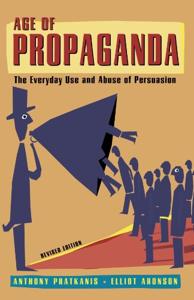
Want to learn the ideas in Age of Propaganda better than ever? Read the world’s #1 book summary of Age of Propaganda by Anthony R. Pratkanis, Elliot Aronson here.
Read a brief 1-Page Summary or watch video summaries curated by our expert team. Note: this book guide is not affiliated with or endorsed by the publisher or author, and we always encourage you to purchase and read the full book.
Video Summaries of Age of Propaganda
We’ve scoured the Internet for the very best videos on Age of Propaganda, from high-quality videos summaries to interviews or commentary by Anthony R. Pratkanis, Elliot Aronson.
1-Page Summary of Age of Propaganda
Overview
In most situations, leaders have to persuade people rather than simply dictate what they want. They do that by manipulating the way we perceive the world around us. By doing so, they are able to get us to act in ways that are favorable to them without our even realizing it.
Persuasion and propaganda are used in many different arenas, including politics. But they’re also used by companies to manipulate us into buying things we don’t really need or joining cults that aren’t good for our health.
The good news is that we can learn to recognize propaganda for what it is. By learning the techniques of propagandists, we can create a better society and make better choices. We’ll look at how Rush Limbaugh’s fans are called “dittoheads,” as well as other strategies used by propagandists.
Big Idea #1: Persuasion is built on rational thought and the weighing of different perspectives.
Persuasion is the act of trying to get someone to do something. It can be used as a negative thing, but it’s often done in an effort to inform others so they can make better decisions. Persuasion is essentially arguing for one side or another, and then disproving any counterarguments that might arise based on facts. People who are persuaded realize their opinions have changed because of what they’ve heard, and they’re okay with that change.
The central route of information processing is used in persuasion.
Persuasion is the process of changing people’s minds and getting them to take action. Persuasion should be done in a way that makes it easy for recipients to understand information-dense messages, since they’re not interested in any old information but rather want to consider different positions on an issue. They’ll devote all their mental faculties to understanding the message and come up with educated decisions by assessing different sources of information.
But not all arguments are straightforward. There’s a technique called propaganda that is used to manipulate people and sway their opinions, and you can find it just about anywhere.
Big Idea #2: Propaganda confuses its message in order to disseminate information without people realizing it.
Persuasion is different from propaganda because it intends to give its targets a chance to hold onto their own opinions. Instead, it catches them off guard and influences them without giving them a fair shot at holding onto their own opinions.
People who are trying to persuade others often distract them with attractive packaging in order to prevent consumers from focusing on the message. This is done through positive language and framing information in a way that makes it more appealing to consumers.
For example, consumers are more likely to buy beef that’s labeled 75 percent lean ground beef than the same product labeled 25 percent fat. Similarly, gas stations advertise a discount on cash purchases when customers are actually avoiding credit card surcharges. Propaganda relies on distracting people from the real message they’re being fed. Advertisers who sell products use reasons for buying their products that can’t withstand much scrutiny.
Advertisers try to distract the viewer from their product’s flaws by bombarding them with lots of things at once. They use music, rapidly changing scenes, and bright colors to keep a person’s attention on their commercial rather than what they’re selling.
Commercials that are meant to be half-watched are still effective, even if people aren’t paying attention. They might expect that they won’t remember them later on, but catchy jingles will remind them of the product and encourage a purchase when they’re at the store. People could pick up one brand over another without having any rational reason for doing so.





